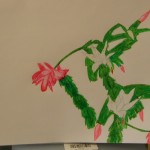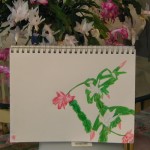INTUITIVE FOCUSING AND CREATIVITY
FOCUSING ON THE CREATIVE EDGE
“Sitting with” The Unclear Edge
Intuitive Focusing, applied to creative expression, is a methodical, predictable road to “Ah, hah!” experiences. Gendlin’s Focusing (Bantam, 1981, 1984) is a step-wise procedure for paying attention to the murky, intuitive, whole-body “feel” of a creative project and going back-and-forth between this Creative Edge and words or images for describing it. When you hit on just the right words or image, you will experience that “Ah, hah! — Yes, that’s it. That is exactly the next step.” With continued rounds of Focusing, you can carry the creative project through many steps of problem-solving.
Focusing simply provides specific steps to encourage the “Ah, hah!” process which creative people have always accessed, usually accidentally. Fortunately, the “unconscious,” or the concretely available Creative Edge, “the intuitive body sense,” can carry more information, all at once, in that murky, wordless “feel,” than we can ever carry in our minds consciously. So, during Focusing, the creative problem-solver has access to “all of it,” “the whole thing,” more than could ever be recited consciously.
From Creative Block To Next Step
-
For example, a painter is stuck on what a particular painting needs next, right now. She can step back, take a look, and then, ask herself, “What does this painting need?” and, instead of answering from her head, the already-known, she can wait, as long as a minute or more, for the bodily-feel, the intuitive sense, the Creative Edge of “the whole thing, and what it needs now — ” to arise as a murky, wordless “feel,” usually in the center of the body, between the throat and stomach — “What does it need?” — and waiting, just paying attention to the intuitive feel — then carefully looking for words or an image or just the right gesture, the next painterly act, the next step toward “completion.” Stuck again later? Just follow the same process, stepping back, sensing in, waiting for “the exactly right” next move to arise.
-
A writer is stuck in a novel: “What does this story need? What does this character need? What happens next?” Again, the writer steps back, takes a moment to go quietly inside, perhaps with eyes closed, and sits with the creative question, setting aside any already-known guesses or solutions, and just waiting, for at least a minute, for the intuitive feel of the “whole thing — this whole question” to arise. Then, just as carefully, he looks for words or images or metaphors that are exactly “right” in capturing the “feel of it all.” And, then, “Ah, hah! That is exactly it.” Or, in writing even more than in painting, he can try out the body’s best guess, and, again, check with the body sense: “Is that it?”
-
Same thing for creative problem solving in a business, engineering, scientific research situation. When “stuck,” not knowing the answer in a left-brain way, the problem solver can simply pause for a moment, go quietly inside, and look for the Creative Edge, the “intuitive feel” for “this whole problem,” wait at least a minute for the intuitive feel to form, then use Intuitive Focusing to carefully find the exact words or images which ,”fit,” bringing that experience of “Ahah! That is exactly it!”
Often, naturally, artists, writers, dancers “check in” with their “intuitive feel” for a project at many steps throughout the creative process. Learning Intuitive Focusing as a specific Skill will enhance this natural process, as well as giving you a reliable tool for those times when you are “stumped” or “blocked” about what comes next.
The Blurry, Vague, “Feel of the Whole Thing” Holds The Next Steps
Intuitive Focusing is one-half of the two Core Skills of Creative Edge Focusing ™. Focusing can be used any time to find out what is bothering you. Focusing specializes in sitting with the vague, wordless intuitive sense that there is something — something you can’t quite put your finger on or put into words, but something definitely determining your behavior or how you feel or the inkling of an idea or solution —
Intuitive Focusing can be used not just for personal problem-solving but for sitting with The Creative Edge of anything: a piece of creative art or writing, an exciting professional problem to solve, a good feeling that has a spiritual edge —
FOCUSING EXERCISE: “SITTING WITH” THE UNCLEAR EDGE OF A CREATIVE PROJECT
I ask you to choose one or more “creative projects” you can spend Focusing time with during this four-week cycle: an article, a book, a poem, a song, a dance, a marketing campaign, an engineering breakthrough, some project needing creative ideas. This week, we will use Intuitive Focusing on the creative project itself. Next week, we will work more specifically on “blocks” that come up.
Focusing On A Creative Problem or Project
(You can read these to yourself now, download them for continuous use, read them into a tape recorder for playback . Leave at least one minute of silence between each instruction)
(One minute)
Okay — first, just get yourself comfortable — feel the weight of your body on the chair — loosen any clothing that is too tight —
(One minute)
Spend a moment just noticing your breathing — don’t try to change it — just notice the breath going in — and out —
(One minute —)
Now, notice where you have tension in your body (pause) —
(One minute — )
Now, imagine the tension as a stream of water, draining out of your body through your fingertips and feet (Pause) —
(One minute — )
Let yourself travel inside of your body to a place of peace —
(One minute — )
Now, bring to mind a creative problem or project that needs attention (pause) —
(One minute or more — )
Think about it or get a mental image of it —
(One minute — )
Now, try to set aside all of your thoughts about possible solutions, and, as you carry a mental image of the problem or project in your mind, just wait and see what comes in the center of your body, around your heart/chest area, in response (pause) — not words, but the intuitive feel of the whole situation, The Creative Edge —
(One minute — )
Now, carefully try to find words or an image for that Edge — Go carefully back and forth between any words and the intuitive feel of the whole thing until you find words or an image that are just right for it —
(One minute — )
Now, gently ask yourself, “Is that it? Would that work here?”, and wait, at least a minute, to see what comes in your wordless intuition, your whole-body sense, The Creative Edge —
(One minute —)
Again, carefully find words or an image that exactly fit that Edge —
(One minute — )
Now, try that possible solution out in the creative situation, either in your imagination or by actually writing, painting, tinkering with a model —
(One minute — )
Now, ask yourself, “Does that work?” and, again, don’t answer from your head, what you already know, but wait, as long as a minute, for an answer to come in the center of your body, your wordless intuition, The Creative Edge —
(One minute — )
Again, carefully find words or an image for that, “Does that solution work?” —
(One minute — )
If the answer is “Yes,” a release of bodily tension, a sense of coming unstuck — then return to the creative project and work again until there is another place of not-knowing, where you can begin the whole Focusing process again —
If the answer is “No,” your body remains tense and your energy still blocked, flat, then, set aside everything you have already thought and tried and ask your “subconscious,” the “intuitive feel” at The Creative Edge, again: “What does this situation need?”, and, again, wait, as long as a minute or more, to see what comes in the center of your chest, an intuitive “feel” for the whole thing —
(One minute)
Take a moment, again, to carefully find words or an image for whatever has come —
(One minute)
Keep at this as long as you are comfortable, asking an open-ended question, waiting for an “intuitive feel” of “the whole thing” to emerge, looking for words or an image or even a gesture or action step that fits the intuitive feel “exactly.”
(One minute or more — )
But, if no clear next step arises, just remind yourself that, by spending Focusing time sitting with The Creative Edge, you have added energy and started a new living-forward, and, especially if you continue to hold “the feel of it all” on the back-burner of your mind, later something new will likely pop up —
(One minute)
Appreciate yourself and your “subconscious,” the “intuitive feel,” for taking time with this, trusting that taking time is the important thing — solutions can then arise later.
Remember, it is often easier to learn Intuitive Focusing with the company of a Focusing Listener. See links below to find many resources, including self-help groups, and Creative Edge Focusing Consultants for individual Coaching or Classes and Workshops.
Download complete Instant “Ahah!” Mini-Manual, in English and Spanish, from CEF Website
Find links to free articles, personality tests, multi-media Self-Help training, Classes and workshops
Dr. Kathy McGuire, Director
The site of new insights and creative solutions is at the edge of what is already known. This edge, The Creative Edge, holds implicit within it all past and future knowing about the problem, more than could ever be put into words in a linear way


